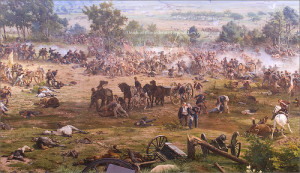An Ancient Loss
Sometimes it take a while to follow up on good intentions. Long ago while en route to our oldest nephew’s graduation on Long Island, we stopped for a couple hours at the visitor’s center at Gettysburg, Pennsylvania.
After also taking a brief self-guided car tour of nearby war monuments, we had to depart. As we pulled away, I said, “I’d like to come back when we have more time to look everything over.”
Twenty years later, we finally made it in mid-July—ironically, while returning from Long Island
The Cyclo-What?
Our first morning we entered a much larger visitors center than the one we saw in 1995. Glancing over the various tours, I noticed one ticket included admission to the museum and “cyclorama.”
After a “huh?” reaction to the latter word, I thought, “I don’t want to take a bicycle tour.”
Turns out I didn’t need to spin any wheels to enjoy this attraction.
Unbeknownst to me, cyclorama paintings were all the rage in the late 18th and 19th centuries. However, the development of motion pictures and television relegated them to history. In my estimation, they ought to be brought back.
Panoramic View
In a nutshell, a cyclorama is a 360-degree, cylindrical painting. The one at Gettysburg depicts Pickett’s Charge, the ill-fated Confederate Army’s infantry assault that marked the climax of the three-day battle.
Words can’t quite capture the kind of breathtaking, panoramic view I saw that day. One, by the way, that isn’t possible with TV and movie screens, no matter how crisp the definition.
As we listened to a presentation, I noticed how the life-size models placed on the floor leading up to the painting seemed to blend with the canvas. That created an effect where it became almost impossible to tell where three-dimensional life stopped and painting began.
This particular cyclorama was painted in the late 1880s by French artist Paul Philippoteaux, who spent months researching the battle with war veterans, a battlefield guide, and a photographer.
It took the artist—who in a cunning bit of self-portraiture, inserted himself into one scene—and his team more than a year to complete the painting. According to the museum web site, the end result measures 377 feet in circumference and 42 feet high.
Wrap your head around that for a minute: longer than a football field and as tall as a four-story building.
Historical Display

photo credit: Ron Cogswell
In checking history further, I learned that four versions of the Gettysburg Cyclorama existed at one time. The version we saw was first exhibited in Boston in 1884 and remained in private hands until the National Park Service acquired it in the 1940s.
When you consider that these creations came to life at a time when modern shipping methods didn’t exist, it is quite amazing that a 132-year-old painting that started in Paris is still around for our enjoyment and education. That is, thanks to a painstaking renovation that closed the exhibit from 2005 through 2008.
Now, the cyclorama wasn’t the only enjoyable part of our three-day stop in Gettysburg. I was particularly impressed with our guide on the park’s bus tour. Fred Wieners, a retired Army officer, was sharp as a tack and answered every question anyone posed about this crucial turning point in the Civil War.
Still, for awe and amazement, nothing caught my eye more than the cyclorama. It says something that, in 2007, a group of North Carolina investors purchased the only other Gettysburg Cyclorama painting known to still exist. They must have seen the same potential I did.




